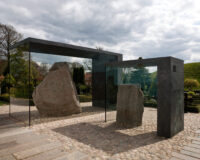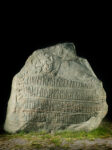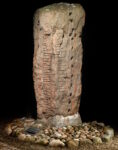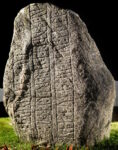 Researchers at the National Museum of Denmark have identified the carver of the runes on the iconic Jelling Stone. His name was Ravnunge-Tue and his boss was Queen Thyra of Jelling (d. 958 A.D.), wife of King of Denmark Gorm the Old (d. 958-9) and mother of Harald Bluetooth, king of Denmark and Norway (ca. 911 – 985 A.D.).
Researchers at the National Museum of Denmark have identified the carver of the runes on the iconic Jelling Stone. His name was Ravnunge-Tue and his boss was Queen Thyra of Jelling (d. 958 A.D.), wife of King of Denmark Gorm the Old (d. 958-9) and mother of Harald Bluetooth, king of Denmark and Norway (ca. 911 – 985 A.D.).
 The large Jelling Stone has been dubbed Denmark’s birth/baptismal certificate because the runic inscription uses the name “Denmark” (“Danmǫrk” in Old Norse) and refers to its conversion to Chritianity. Harald Bluetooth had it carved as a memorial monument for his parents, but added his own credits at the end, describing himself as “that Haraldr who won for himself all of Denmark and Norway and made the Danes Christian.”
The large Jelling Stone has been dubbed Denmark’s birth/baptismal certificate because the runic inscription uses the name “Denmark” (“Danmǫrk” in Old Norse) and refers to its conversion to Chritianity. Harald Bluetooth had it carved as a memorial monument for his parents, but added his own credits at the end, describing himself as “that Haraldr who won for himself all of Denmark and Norway and made the Danes Christian.”
The smaller of the Jelling stones is the earlier of the two. It was erected by Gorm the Old as a memorial to Thyra whom he lovingly describes as “Denmark’s adornment.”
3D scans of runestones enable researchers to gain a close-up view of traces of the carving process. This means they can tell the carving technique of the different rune stones apart. Every experienced stonemason holds his chisel at a certain angle and strikes the hammer with a specific force: this is visible in the angle of the traces of the carving and the distance between them. The motor function developed in such work is individual.
 The carving technique on the large Jelling Stone matches that of the runes on the Læborg Stone found in a field near Læborg Church 20 miles southwest of Jelling. The author helpfully signed the inscription on the Læborg Stone. It reads: “Ravnunge-Tue carved these runes in memory of Thyra, his queen.” He also gave himself and his two collaborators credit on the Bække 1 runestone found a mile from Bække Church. That inscription reads: “Ravnunge-Tue and Fundin and Gnyple, these three made Thyra’s mound.”
The carving technique on the large Jelling Stone matches that of the runes on the Læborg Stone found in a field near Læborg Church 20 miles southwest of Jelling. The author helpfully signed the inscription on the Læborg Stone. It reads: “Ravnunge-Tue carved these runes in memory of Thyra, his queen.” He also gave himself and his two collaborators credit on the Bække 1 runestone found a mile from Bække Church. That inscription reads: “Ravnunge-Tue and Fundin and Gnyple, these three made Thyra’s mound.”
 In total, seven of the runestones in Jutland were 3D scanned for this project: the two Jelling stones, the two Bække stones, the Læborg stone, the Home stone and the Randbøl stone. The runes on the smaller Jelling Stone were too worn for the signature chiseling techniques to be detectable. It’s possible Ravnunge-Tue carved that one too.
In total, seven of the runestones in Jutland were 3D scanned for this project: the two Jelling stones, the two Bække stones, the Læborg stone, the Home stone and the Randbøl stone. The runes on the smaller Jelling Stone were too worn for the signature chiseling techniques to be detectable. It’s possible Ravnunge-Tue carved that one too.
This identification answers a long-standing question about whether the Queen Thyra mentioned on the Jelling Stones was the same person as the Thyra mentioned on the Læborg Stone. The fact that Thyra and Gorm’s rune carver made the runes on the large Jelling Stone as well as the Læborg runes strongly suggests this was the same queen, not two people who happened to share a popular name. That means Queen Thyra was on at least four rune stones, more runic mentions than anyone else in Viking era Denmark, twice the number of mentions her husband and son got.
“This means that Queen Thyra was far more important than we previously assumed. She probably came from a nobler, older family than Gorm the Old, whom we usually refer to as the first King of Denmark. This is extremely interesting when it comes to understanding the power structure and the genesis of Denmark as a nation,” says [Denmark National Museum runologist] Lisbeth Imer.
All four rune stones that mention Thyra are located in Southern Jutland, implying that her power was based in this area, while Gorm the Old may have come from elsewhere.